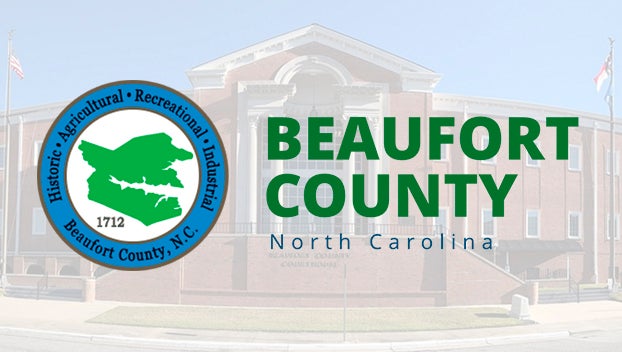Lower taxes vs. fund balance, officials provide background
Published 3:00 pm Thursday, June 15, 2023
|
Getting your Trinity Audio player ready...
|
Editor’s Note: This story has been updated to include quotes from sources given after press time.
Lowering property taxes sounds appealing; however the reality of doing so could cause more headaches than the idea is worth, according to some public officials.
Beaufort County Commissioner Hood Richardson shared his idea of how the county could lower property taxes.
Richardson shared his idea at the commissioners’ regular meeting on Monday, June 5 before the board voted to approve the county’s annual budget. Richardson and Commissioner Stan Deatherage voted in opposition to the plan.
Richardson claimed Beaufort County has more than $25 million in savings and removed $5.4 from a savings fund and deposited it into a special capital spending ordinance, this year which he says is still a savings fund. He also claimed the county increased funds for Beaufort County Schools and Beaufort County Community College. The county funded the continuation budget and increased spending, he said. He continued to say that tax revenues are increasing by more than ten percent at an annual rate due to inflation. Inflation, he said, is the reason why “many families” in Beaufort County are “having hard times” and the reason why county tax revenue is increasing.
Richardson made a motion to reduce the county property tax rate to $0.585 from $0.625 in an effort to “show compassion to the people who earn our tax money by reducing the ad valorem taxes by five cents,” he said. He believed it would cost the county $3.5 million and could easily come from the fund balance.”
Richardson said later after press time the five cent decrease he proposed was an “arbitrary, nice, round number.”
The commissioners voted down the motion 5-2. Those opposed were Chairman Frankie Waters, Vice Chairman Jerry Langley, Commissioners Ed Booth, John Rebholz and Randy Walker. Those who voted in favor were Richardson and Deatherage.
To give residents perspective on the budget, County Manager Brian Alligood provided a crash course on county finance. The first lesson is that the fund balance is designed to hold money that can be used when there is an unanticipated and/or unavoidable event that could have a negative effect on county finances and possibly put necessary public services in jeopardy. Too, fund balances help Beaufort County meet operating needs from July 1 through December when the county collects taxes in that five month period. In January of the following year, taxes become delinquent.
Many residents pay their taxes toward the end of December; therefore, the county sets aside revenue it receives from property taxes to pay for operating needs, fees and/or unexpected expenses. Property taxes account for 56.5% of the county’s annual revenue. “Revenues don’t start coming in until later, but we’ve still got to operate in that dead time,” Alligood said.
Sales tax is collected in those months; however, it is used to fund public education.
The county’s fund balance is 35% of its total $72 million budget for fiscal year 2023-2024 which is higher than the recommended eight percent by the State Treasurer’s Office but similar to surrounding counties. Beaufort County’s fund balance is higher, because it needs to account for natural disasters that could occur. The estimated unassigned fund balance in the 2023-2024 budget is $26.7 million.
Though the State Treasurer’s Office recommends at least eight percent, the Government Finance Officers Association recommends 25%, or about three months. Alligood said Beaufort County sits at about 35%, because of the possibility of hurricanes and emergencies.
“Why are we ten percent higher than that? Because of our position in North Carolina, and our issues with hurricanes, emergencies and things like that. So, 35% is not unreasonable, from the board’s perspective, about what we need to do to maintain a solid financial footing for the county,” Alligood said.
The percentage of money going into a fund balance can be any number and is voted on by the commissioners. To change it, a majority vote and a change in budget policy are required.
In Richardson’s opinion, the fund balance should be around $16 million total to include the eight percent recommendation plus money to sustain the county for several months. Going by the eight percent minimum, the county would have an approximate $6 million in the fund balance. “From a practical standpoint,” Richardson said, “you need about two to three times that amount, because you have to run the government from the effective date that the minimum takes hold which is the beginning of the fiscal year which is on July 1.”
“You still have revenues coming in, but if you get below or get to that eight percent, you’re probably going to wind up having to borrow money to finish the year. So, you need like $16 million, $17 million. We’re still far above what we’re required to have,” Richardson said.
The county needs a fund balance closer to 16%, according to Richardson. He believes tax bills should be sent out as soon as possible, because “a lot of people do start paying their tax bills as soon as they get them, but people like me, I wait until the last day of December to pay my bill.”
When a weather event like Hurricane Florence in 2018 occurs, the county has to pay for damages and clean up before FEMA can reimburse them; therefore, money is set aside in the unassigned balance so that when there is an event, the county can operate without suspending public services.
“It can take up to a year for us to get that money back,” Alligood said about reimbursements from FEMA. “One of the concerns the board has expressed as a whole is ‘do we have enough funds to be able to get through that?’”
Though the Board of Commissioners could borrow money instead of using money from the fund balance, it does not fall in line with the aforementioned policy in place to have funds available when an unpredictable event happens.
“The Board, could if they wanted to, take our fund balance down to nothing. It wouldn’t be very smart…Plus it’s in violation of their own policy,” Alligood said.
When the county fills the unassigned fund balance with 35% of the total budget, any money leftover can be used for capital projects or pay outstanding debt, contingent upon board approval.
“So what they said is, we want this much pot of money sitting aside that’s available for emergencies and things that we need, anytime we go above that, the policy says we can go to the board and say do you want to use this money to pay down your debt or do capital projects,” Alligood said.
These capital projects can include maintenance work and improvements made to county owned facilities.
Richardson said if the fund balance was used to lower taxes, then residents would have more money.
“If that money were in circulation, the community would be a lot more prosperous,” Richardson said.
Having money set aside in a fund balance helps to not only pay for capital projects and pay outstanding debts, but it also assists in maintaining a consistent tax rate, according to Alligood.
Should there be an unexpected cost for the county, if they don’t have money set aside, they may have to raise taxes to cover that cost. This can put residents on a “tax rate rollercoaster” if the county used money from the fund balance to lower taxes like Richardson suggested. Where it had been lowered in this illustration, now it has to increase to cover an expense.
Alligood believes the best management practice is to maintain a tax rate which the county has done for the last three years.
“Don’t go up, down. Don’t get this up and down, up and down. That’s difficult for people to sustain. That’s difficult for them to adjust to. If you can take a tax rate and maintain it over the years by growth, by cutting certain things, being more efficient then to me that is better than saying ‘okay, well, this year, we’re going to drop the tax rate. Oh but next year, we’re going to raise it back up then we’re going to drop it, then raise it. That in my opinion is not the best way to do it,” Alligood explained.
Alligood said the Board of County Commissioners could vote to lower taxes by five cents with a majority vote, but by lowering the tax rate, they would need to find a consistent revenue source. This would level the tax rate with money needed to meet the 35% fund balance.
Alligood says the money in the fund balance is for “one-time” items like one project or one debt.
“What you don’t want to do is use one-time money for recurring events. We try to recommend you spend one-time money on one-time expenditures. If you want to cause cuts that are continuing cuts then you need to find a continuing revenue stream to sustain that or you need to make cuts in the operations to lower that so that you’re not spending one-time money.”
Richardson maintains his opinion that county commissioners “are supposed to represent the public. We don’t represent the county employees…We are elected to represent the fiduciary interests of the public, and when we take their money and we put it in bank accounts and sit on it and not give it back – we are not treating the public kindly.”






